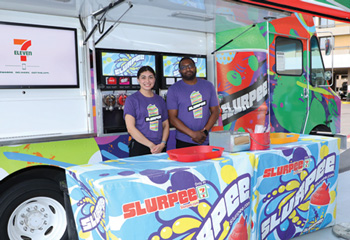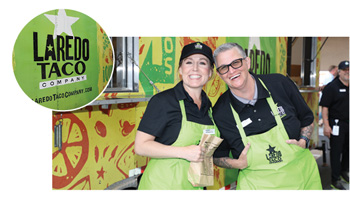What did the 2023 NACS State of the Industry Summit reveal? Amid the insights, analysis, forecasting, benchmarking, opinions and most of all, data, there were a few big takeaways.
1. Records Are Made to Be Broken
Records tumbled everywhere. This year’s SOI Summit set records for attendance, both overall and from retailers. There also were a record number of participants sharing data.
But the more impressive records were made by the industry’s performance, led by foodservice, which was up 14.3%. As a category, prepared food unseated cigarettes as the top category (20.4% of in-store sales) and extended its hold on in-store profits (30.8%). This marked the first time that prepared food led all categories in both sales dollars and gross profit dollars.
Foodservice sales helped push in-store sales to a record $302.8 billion. In-store sales have hit records every year since 2002.
Meanwhile gas sales, propelled by higher gas prices in 2022, helped push overall sales to a record $906.1 billion, which means that c-store sales account for roughly 3.6% of the U.S. gross domestic product. If U.S. convenience store sales were a country, they would rank as the 20th-largest economy in the world, below Turkey ($1.03 trillion) and above Switzerland ($870 billion).
Gas sales, propelled by higher gas prices in 2022, helped push overall sales to a record $906.1 billion, which means that c-store sales account for roughly 3.6% of the U.S. gross domestic product.
2. Foodservice Is Our Future—And Present
Foodservice sales and profits numbers as a category were impressive. But even more impressive is the effect that foodservice has on overall sales. In benchmarking store operations based on store operating profit, top quartile performers had a foodservice mix that was 3.2 times greater than those in the bottom quartile (31.1% of inside sales vs. 9.6%) and foodservice gross profits that were 3.4 times those of the bottom quartile (42.4% of in-store profits vs. 12.5%).
The top decile had 5.5 times the foodservice sales of the bottom decile, and 1.4 times more transactions. “Mix matters,” said Lori Buss Stillman, NACS vice president of research and education.
It can’t be just ‘good food’ that you’re known for. It has to be specific.
The category of prepared food, which is within foodservice, is incredibly broad, ranging from sandwiches and other hand-held meals to gourmet offerings that are best eaten at a table. The key is to define what you are famous for. For Casey’s, it’s pizza. For Wawa, it’s hoagies. “It can’t be just ‘good food’ that you’re known for. It has to be specific. You can do multiple things—but you must be focused,” said Henry Armour, NACS president and CEO.
Innovation is also critical. A NACS research study found that 64% of retailers are constantly implementing new or evolving current foodservice offerings to match the latest consumer trends. Art Sebastian, vice president of omnichannel marketing at Casey’s, also stressed that you shouldn’t let perfection get in the way of bringing a new innovation to market. “Build MVPs (minimally viable products). You can always enhance them once you get them out the door.”
One thing you don’t want to be known for with your foodservice program: A foodborne illness. Retailers reported that 17.7% of annual foodservice training is for food-safety training, said Annie Gauthier, CFO and Co-CEO of St. Romain Oil Co. and Y-Not Stop. That may not be enough.
3. DSOE Increases … Especially Credit Card Swipe Fees
Direct store operating expenses climbed 10.6%, putting pressure on retailers despite positive sales growth.
Chief among the rising expenses were credit card swipe fees, which increased a staggering 82% between the start of 2020 and the end of 2022 and now stand at $19.5 billion.
Remember that credit card ticker at the NACS Show that showcased swipe fees in real time? Here are the new numbers: $53.4 million a day, $2.2 million an hour, $37,100 a minute and $618 a second. Don’t blink because during that time the credit card industry just collected a few hundred dollars from c-stores. It’s truly outrageous.
Labor costs also increased. Average wages increased 9.1% for full-time and 12.6% for part-time employees to $14.33 per hour and $14.02 per hour, respectively.
Convenience stores are labor-intensive, but Armour said that’s not an entirely bad thing. “If your store isn’t on a freeway, 80% of the people you see are repeat customers. The uniquely personal relationships we have with our customers is an enduring competitive advantage,” said Armour.
“Do you think that McDonald’s employees have that relationship?” Armour asked, fully knowing the answer.
The value of that personal connection requires retailers to look at labor productivity differently. Yes, labor is an expense. But it’s also an asset. “You can look at it as how do I reduce labor costs—or how can I pay my people more and get more from them,” said Armour.
There’s a playbook for that. NACS has partnered with the Good Jobs Institute, which created a model that demonstrates that higher pay can create a virtuous cycle of more productivity—if done right. Convenience retailers Loop Neighborhood Markets, Thorntons and Noria Energy are all working with the group. Interested? Go to www.convenience.org/Topics/Employee-Engagement/The-Good-Jobs-Strategy.
The bottom line is that labor is a growing DSOE, but the people behind that expense directly benefit your business. The same can’t be said for swipe fees.
4. Fuels’ Demise May Be Greatly Exaggerated
Nobody’s predicting that U.S. fuels sales will ever top the record 9.329 million barrels (392 million gallons) of motor fuels consumed per day in 2018, but sales are not declining. In fact, with over 2,000 new fuels sites in the U.S., there was a slight 0.7% increase in gallons sold in 2022 despite consumer concerns over record gas prices.
If your store isn’t on a freeway, 80% of the people you see are repeat customers.
There are challenges. Commuting still hasn’t come back, noted NACS Director of Analytics Leroy Kelsey. Last year, 26% of all trips were from commuting, a 9-point drop from the 35% of trips that were commutes in 2019. And, higher fuel efficiency standards also are reducing trips to the gas pump, noted Denton Cinquegrana, chief oil analyst at OPIS. He said that CAFE standards and the continuing embrace of work at home, especially in large cities, has a bigger adverse effect on fuel sales than the growth of electric vehicles (EVs).
While sales of EVs are increasing, they still account for less than 1% of all registered vehicles in the United States. In addition, EVs are very, very localized, concentrated heavily in only 15 states.
What’s it all mean? One of Armour’s favorite quotes is from author William Gibson: “The future is already here—it’s just not evenly distributed.”
In Our Backyard’
This year, the NACS State of the Industry Summit moved out of its traditional home in Chicago to Dallas. (It returns to Chicagoland next year.)
The move made it easier for companies in the region to send representatives, and Dallas-based 7-Eleven Inc. took full advantage. Not only did the retailer send nearly 90 leaders, it also gave back, bringing food and Slurpee trucks to share its Laredo Taco Company offerings and iconic Slurpee drinks.
NACS talked to Randy Quinn, senior vice president of franchise operations at 7-Eleven, about the strategy of bringing the team to the Summit.
 Tell us about 7-Eleven’s involvement in the SOI Summit this year.
Tell us about 7-Eleven’s involvement in the SOI Summit this year.
We’ve always sent a contingent to the SOI Summit. Then two things happened. One is the event is in Dallas, so there’s a sense of pride in us bringing both people, and the popular Slurpee truck and Laredo Taco Company food truck. 7-Eleven and the convenience store industry were born in Dallas and it continues to be where our Store Support Center is located. And it just so happened the SOI Summit was in the same timeframe as our quarterly operations summit. We had operations leaders from across the country in town during the same week. And that’s why we had to jump on it. We got lucky with this one.
 Was there anything you were particularly looking forward to learning?
Was there anything you were particularly looking forward to learning?
We’re really interested to learn about what’s going on in the industry, where other companies in the industry are experiencing challenges and identifying opportunities, and then sharing best practices. NACS has done a good job over the years of double-clicking into not just the macro number or the aggregate number, but how are things in the West? How are things in the East? How are things in the Midwest? And, as a national convenience retailer, that matters to us. We’re really interested in that.
The last three years there have been numbers and then there have been trends. Is there a way you look at what is a trend, what’s a number? We ask because stuff’s been different the last couple of years.
It really has, and there’s a little bit of a regional element to it. When COVID hit, by and large, the industry was resilient. But not everywhere had the same experience.
Our stores that were in very urban areas surrounded by offices and downtown areas saw more extreme COVID-19 precaution measures, while our stores out in the open suburbs and even in rural areas experienced new traffic patterns compared to before the pandemic.
I think there are a couple of trends happening. One is on the revenue side, you have this big change in customer traffic. We’re always looking at customer counts and traffic because it is the lifeblood of any brick-and-mortar retail business. It’s not cliche, it’s genuine—it’s the lifeblood of the business. We really have our eyes on the customer count and the impact of inflation.